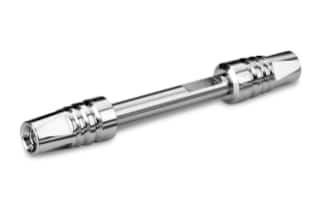
|
Chemistry |
C4 |
|
Separation Mode |
Reversed Phase |
|
Particle Substrate |
Hybrid |
|
pH Range Min |
2 pH |
|
pH Range Max |
10 pH |
|
Endcapped |
No |
|
Silanol Activity |
Low |
|
Molecular Weight Range Max |
150000 |
|
Particle Shape |
Spherical |
|
Particle Size |
1.7 µm |
|
Endfitting Type |
Parker-style |
|
Pore Size |
300 Å |
|
QC Tested |
Protein |
|
Format |
Column |
|
System |
UPLC, UHPLC |
|
Particle Technology |
BEH |
|
USP Classification |
L26 |
|
Inner Diameter |
1 mm |
|
Length |
50 mm |
|
Carbon Load |
8 % |
|
UNSPSC |
41115709 |
|
Application |
Protein |
|
Brand |
ACQUITY UPLC |
|
Product Type |
Columns |
|
Units per Package |
1 pk |

ACQUITY UPLC Protein BEH C4 Column | 300Å | 1.7 µm | 1 mm X 50 mm | 1/pk | 186005589
Waters created the 2nd generation hybrid Ethylene Bridged Hybrid (BEH) Particle technology after extensive research following the success of the XTerra and Hybrid Particle Technology (HPT). The premise of BEH Technology is to assist columns with seamless migration between HPLC and UPLC Technology platforms. With the use of BEH particle Technology, you will be able to develop robust methods across an unparalleled range of temperature, mobile-phase pH, and pressure to improve system-wide efficiency and achieve results faster.
In contrast to the traditional C18 phases, the C4 ligand used in the ACQUITY UPLC Protein BEH C4 Column is less retentive and will minimize protein carryover, increase protein recovery, and improve peak capacity. The ACQUITY UPLC Protein BEH C4 Column is based on Waters Protein Separation Technology (PrST). These columns are QC tested and optimized to separate proteins based on size, hydrophobicity, and isoelectric point, making the analytical column a crucial piece of lab equipment.
The ACQUITY UPLC Protein BEH C4 Column is ideally suited for high-resolution separations of proteins as it enables the differentiation of minor isoforms of either heavy or light chain, providing an enhanced assessment on the heterogeneity of a protein sample. ACQUITY UPLC Protein BEH C4 Columns can tolerate pressures up to 15,000 psi (1034 bar) in applications run on the ACQUITY UPLC System and contains Waters patented BEH Technology C4, 300Å pore, and 1.7µm particles.
If you would like to explore additional equipment offerings from Waters, please browse through our brochure or check out our website, where you can shop for lab equipment. If you need any support or guidance in equipment selection or have any general questions or concerns, you can connect with a member of our global support team from our website who would be happy to assist you.
You might also be interested in reviewing the ACQUITY UPLC Protein BEH C4 VanGuard Pre-column, 300Å, 1.7 µm, 2.1 mm X 5 mm, 10K - 500K, 3/pk. The VanGuard pre-column connects directly to the inlet of the ACQUITY UPLC column, which minimizes extra columns volumes and reduces leaking by eliminating additional connections.
What Is The Operational Temperature Range Within Which The ACQUITY UPLC Protein BEH C4 Column Operates Optimally?
The ACQUITY UPLC Protein BEH C4 Column can operate optimally within 20 - 90 degrees Celsius; it can also manage a pH range of 2 - 11, with up to 15,000 psi (or 1034 Bar). However, you should note that operating the system and/or your column at temperature or other settings, such as pH and pressure, close to the edges of the limit or outside of it, can drastically impact your column’s lifetime and performance and decrease them significantly.